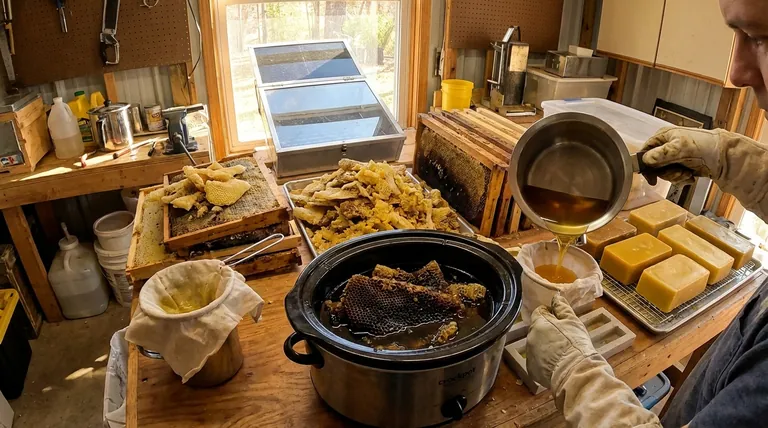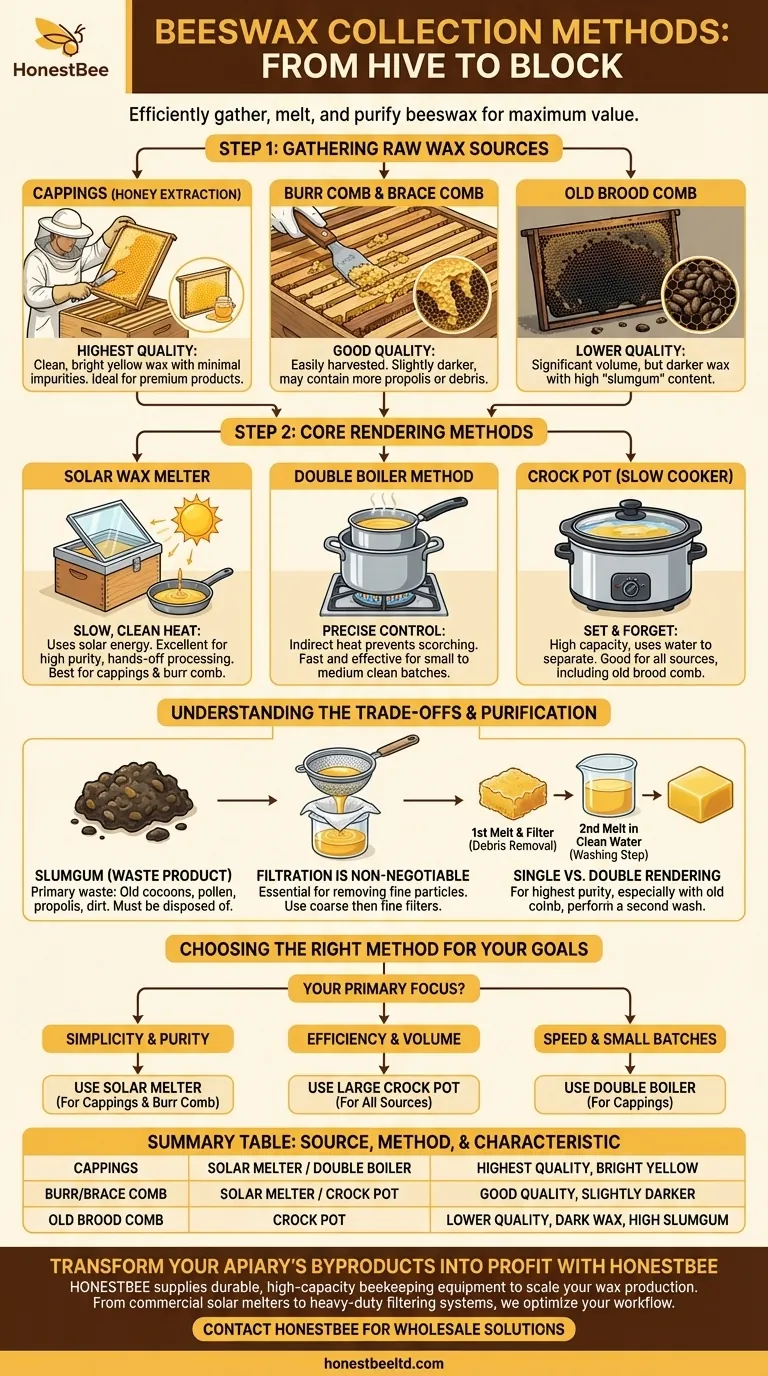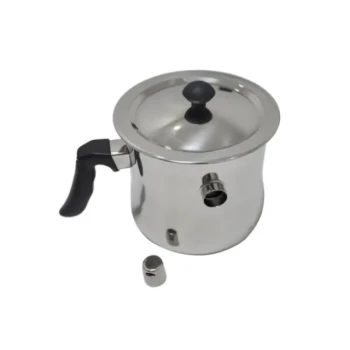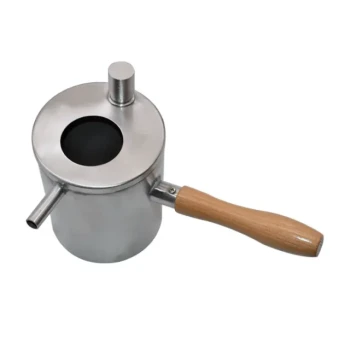To collect beeswax, you must first gather wax-rich materials from the hive and then use heat to melt and separate the pure wax from impurities. The primary sources of wax are cappings removed during honey harvesting, excess burr comb, and old, dark brood comb. The most common rendering methods involve using a solar wax melter, a double boiler, or a crock pot to melt the raw comb, followed by a filtering process.
The core challenge in collecting beeswax is not simply melting it, but efficiently separating the pure wax from residual honey, bee cocoons, and other hive debris. Your choice of method will depend on the quantity and source of your raw comb, balancing speed, energy cost, and final wax purity.

Step 1: Identifying and Gathering Raw Wax Sources
Before you can render wax, you must collect it from your hives. The quality and color of your final beeswax block are directly determined by its source.
Cappings from Honey Extraction
This is the highest quality wax you can collect. These are the fresh, clean wax coverings that bees build over cells of cured honey.
When you uncap frames for honey extraction, save these wax cappings. They have the lowest level of impurities and render into a bright, beautifully fragrant yellow beeswax.
Burr Comb and Brace Comb
Bees often build excess comb in places beekeepers don't intend, such as between frames or on top bars. This is known as burr comb or brace comb.
This wax is easily scraped off during routine hive inspections. While still high quality, it may contain more propolis or debris than cappings, potentially resulting in a slightly darker final product.
Old Brood Comb
Frames that have been used for raising brood for several seasons become dark and heavy. This is a significant source of wax, but it is of lower quality.
These old combs are saturated with pupal cocoons, pollen, propolis, and other materials collectively known as "slumgum." While you can harvest a large volume of wax from them, the rendering process is messier and the final wax will be much darker.
Step 2: Core Methods for Rendering Beeswax
Once you have collected your raw comb, the next step is to melt it down to separate the wax.
The Solar Wax Melter
A solar wax melter is essentially an insulated box with a glass lid, designed to use the sun's energy to melt wax. The raw comb is placed on a tray, and as the wax melts, it runs down and collects in a separate container.
This method is highly efficient for producing very clean wax because the slow, gentle heat doesn't scorch the wax or mix impurities into it. It is the most hands-off and energy-free option.
The Double Boiler Method
This classic kitchen technique provides excellent temperature control. You place a smaller pot containing the raw wax and some water inside a larger pot of simmering water.
The indirect heat prevents the wax from overheating, which can damage its color and aroma. This method is fast and effective for small to medium batches, especially when processing clean cappings.
The Crock Pot (Slow Cooker) Method
Using a large crock pot is an excellent "set it and forget it" option for rendering. You add the raw comb and an equal amount of water to the pot and set it on low for several hours.
The wax melts and floats on top of the water, while heavier debris and water-soluble impurities sink to the bottom. After cooling, you are left with a solid disk of wax that can be easily lifted off the dirty water below.
Understanding the Trade-offs
Collecting beeswax is a process of purification. Every method involves separating valuable wax from less desirable materials.
The Challenge of Slumgum
The primary waste product from rendering beeswax is slumgum—a sticky, dark mass of old cocoons, pollen, propolis, and dirt.
Old brood comb produces a very high ratio of slumgum to wax. Solar melters are particularly good at separating wax from slumgum, but any method will require you to handle and dispose of this residue.
Filtration is Non-Negotiable
No matter which melting method you choose, you must filter the molten wax. A coarse filter (like a kitchen strainer) can remove large debris first.
For a finer filtration, pour the hot wax through several layers of cheesecloth, a paper towel, or an old t-shirt. This step is critical for removing fine particles and achieving a clean, smooth final product.
Single vs. Double Rendering
For the highest purity, especially when starting with old comb, consider a two-step process. The first melt and filtration remove the bulk of the debris.
You then re-melt this semi-clean block of wax in fresh, clean water. This "washing" step allows even more fine impurities to settle out, resulting in a significantly cleaner and higher-quality final block of beeswax.
Choosing the Right Method for Your Apiary
Your ideal collection strategy depends on your scale and goals.
- If your primary focus is simplicity and purity with a few hives: Use a solar melter for your cappings and burr comb to produce premium, bright yellow wax with minimal effort.
- If your primary focus is processing moderate volumes efficiently: A dedicated large crock pot offers a great balance of capacity and ease of use for rendering wax from all sources, including old brood comb.
- If your primary focus is speed for small, clean batches: The double boiler method gives you precise control to quickly render your valuable cappings into clean wax on demand.
By matching your collection method to your wax source and goals, you can efficiently turn a natural byproduct of your apiary into a valuable resource.
Summary Table:
| Wax Source | Best Rendering Method | Key Characteristic |
|---|---|---|
| Cappings (Honey Harvest) | Solar Melter / Double Boiler | Highest quality, bright yellow wax |
| Burr/Brace Comb | Solar Melter / Crock Pot | Good quality, may be slightly darker |
| Old Brood Comb | Crock Pot | Lower quality, dark wax, high slumgum |
Transform Your Apiary's Byproducts into Profit with HONESTBEE
Efficiently collecting and rendering beeswax is a key step in maximizing the value of your beekeeping operation. As a commercial apiary or equipment distributor, you need reliable, high-capacity solutions.
HONESTBEE supplies the durable beekeeping supplies and equipment you need to scale your beeswax production, from heavy-duty solar wax melters to commercial-grade filtering systems. Let us help you optimize your workflow and turn wax into a significant revenue stream.
Contact HONESTBEE today to discuss wholesale equipment solutions tailored for your commercial needs.
Visual Guide

Related Products
- Beeswax Melter for Candle Making Honey Bee Wax Melter
- Steam Beeswax Melter Wax Warmer for Wax Processing
- Professional Stainless Steel Wax Melter for Beekeeping and Crafts
- Honey Wax Separating Wax Press with Metal Screw Wax Separator Machine
- Electric Flatting and Embossing Machine with Tray for Beekeeping
People Also Ask
- What is the best way to melt beeswax for candles? The Safest Method for Professional Results
- What are the main types of wax melters? Choose the Right Heating Method for Your Needs
- What makes polyurethane foam environmentally friendly? The Surprising Benefits of a Durable, Inert Material
- What are the benefits of using a professional wax melter? Achieve Consistent, Scalable, and Safe Production
- How do water jacket melters function? Achieve Gentle, Scorch-Free Melting for Sensitive Materials



















